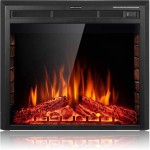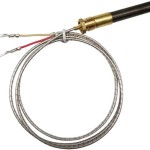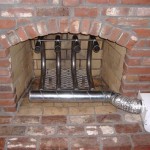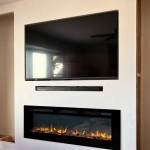Propane Inserts For Fireplace: A Comprehensive Guide
Fireplace inserts offer a practical method to convert an existing inefficient fireplace into a more effective heating source. Among the various fuel options, propane inserts have gained significant popularity due to their convenience, efficiency, and relatively clean-burning nature. This article provides a detailed overview of propane fireplace inserts, discussing their functionality, advantages, installation considerations, maintenance requirements, and cost factors.
A propane fireplace insert is essentially a sealed firebox that is installed directly into an existing masonry or factory-built fireplace opening. It operates by burning propane gas to generate heat, which is then circulated into the room through convection or a blower system. This contrasts with traditional open fireplaces, which often lose a significant portion of their heat up the chimney, resulting in low heating efficiency. Propane inserts, on the other hand, are designed to maximize heat output and minimize heat loss, thereby providing a more cost-effective and comfortable heating solution.
Understanding the Functionality of Propane Fireplace Inserts
The core function of a propane fireplace insert is to provide efficient and controlled heating. This is achieved through several key components working in unison. The propane gas is supplied to the insert from an external propane tank, either a portable tank or a larger, permanently installed tank. The gas is regulated by a valve system within the insert to control the flame height and heat output. Ignition is typically achieved through a pilot light or an electronic ignition system, which provides a reliable and convenient method for starting the fire.
Once ignited, the propane burns within the sealed firebox, generating heat. The firebox is typically constructed from cast iron or steel, materials known for their durability and heat retention properties. The design of the firebox is crucial for maximizing heat transfer. Many propane inserts incorporate baffles and other heat exchangers to increase the surface area available for heat absorption. This allows the insert to extract more heat from the combustion process before the exhaust gases are vented through the existing chimney.
The generated heat is then distributed into the room through one of two primary methods: convection or forced-air circulation. Convection models rely on the natural circulation of air. As the air around the insert heats up, it rises, drawing cooler air in from below. This natural airflow distributes the heat throughout the room. Forced-air models, on the other hand, utilize a blower fan to circulate the heated air. This method is generally more effective at distributing heat over a larger area and can provide a more consistent room temperature.
Modern propane fireplace inserts often include advanced features such as thermostatic controls, which allow users to set a desired room temperature and automatically adjust the burner output to maintain that temperature. Programmable timers are also common, allowing users to schedule the insert to turn on and off at specific times. Some models even offer remote control operation, providing added convenience and control over the heating process.
Advantages of Choosing Propane Fireplace Inserts
Propane fireplace inserts offer a multitude of benefits compared to traditional fireplaces and other heating alternatives. One of the most significant advantages is their increased heating efficiency. As mentioned earlier, open fireplaces are notoriously inefficient, with a significant portion of the heat escaping up the chimney. Propane inserts, however, are designed to maximize heat output and minimize heat loss, resulting in a much more efficient heating solution. This translates to lower heating bills and reduced energy consumption.
Another key advantage is the convenience of propane as a fuel source. Propane is readily available and can be easily delivered to homes. Unlike wood-burning fireplaces, which require a constant supply of firewood, propane inserts offer a hassle-free heating experience. There is no need to chop wood, stack it, or worry about running out of fuel in the middle of the night. Simply ensure that the propane tank is adequately filled, and the insert will provide consistent and reliable heat.
Propane inserts also offer greater control over the heating process. With features such as thermostatic controls and programmable timers, users can precisely regulate the temperature and schedule the insert to operate according to their specific needs. This level of control is not possible with traditional fireplaces, which are often difficult to regulate and can lead to overheating or underheating.
In addition to their efficiency and convenience, propane inserts are also relatively clean-burning. Propane combustion produces significantly fewer emissions than wood burning, making it a more environmentally friendly heating option. This can be particularly important in areas with air quality concerns or for individuals who are sensitive to smoke and particulate matter.
Finally, propane inserts offer a visually appealing alternative to traditional fireplaces. Many models feature realistic-looking artificial logs and flames, creating a cozy and inviting ambiance. They are available in a variety of styles and finishes to complement any décor, allowing homeowners to enhance the aesthetic appeal of their living space while enjoying the warmth and comfort of a fireplace.
Installation and Maintenance Considerations
The installation of a propane fireplace insert typically requires professional expertise. It is crucial to ensure that the insert is properly sized for the fireplace opening and that it is installed in accordance with manufacturer's instructions and local building codes. A qualified technician can assess the existing chimney to determine if it is suitable for venting the exhaust gases from the propane insert. In some cases, it may be necessary to install a new chimney liner to ensure proper venting and prevent the build-up of dangerous gases such as carbon monoxide.
Connecting the propane insert to the propane supply line also requires specialized knowledge and skills. It is essential to ensure that the connections are leak-proof and that the gas pressure is properly regulated. A qualified technician can safely and properly connect the insert to the propane supply, minimizing the risk of gas leaks or other hazards.
Once installed, propane fireplace inserts require regular maintenance to ensure optimal performance and safety. This typically includes annual inspections and cleaning by a qualified technician. The technician will inspect the burner, pilot light, and venting system to ensure that they are functioning properly. They will also clean the firebox and glass door to remove any soot or debris that may have accumulated during operation. Regular maintenance can help to extend the life of the insert and prevent costly repairs.
In addition to professional maintenance, homeowners can also perform some basic maintenance tasks themselves. This includes regularly cleaning the glass door with a non-abrasive cleaner to remove any soot or smudges. It is also important to keep the area around the insert clean and free of flammable materials. Check the batteries in the remote control, if applicable, and replace them as needed. Regularly check the propane tank level to ensure an adequate supply of fuel.
Proper ventilation is crucial for the safe operation of a propane fireplace insert. Ensure that the chimney is properly vented and that there are no obstructions that could impede the flow of exhaust gases. Never block or restrict the air vents on the insert, as this can lead to overheating and potential safety hazards. Install carbon monoxide detectors in the home and test them regularly to ensure that they are functioning properly. Carbon monoxide is a colorless and odorless gas that can be deadly, so it is important to have working detectors to provide early warning in case of a leak.
Propane fireplace inserts offer a convenient and efficient way to heat a home. They are generally safer and cleaner than traditional wood-burning fireplaces, and they offer greater control over the heating process. However, it is important to follow proper installation and maintenance procedures to ensure safe and reliable operation. Consulting with a qualified technician is recommended to determine the appropriate size and type of insert for a specific fireplace and to ensure that it is installed and maintained correctly.

Gas Fireplace Insert Propane Regency Vermont Castings Napoleon

Gas Propane Fireplace Inserts Page 2 Of 4 Coalway Ohio

Propane Fireplace Inserts Gas Log Sets Tunkhannock Pa Ace Robbins

Why Install A Propane Fireplace Paraco Gas

Duluth Forge 27 In W 26000 Btu Black Vent Free Dual Burner Gas Fireplace Insert The Inserts Department At Com

Enviro E Series Gas Or Propane Insert Fireplace Fireplaces By Cameron

Gas Fireplace Inserts Fireplacesdirect Com

Bluegrass Living 27 In W 26000 Btu Black Vent Free Dual Burner Gas Fireplace Insert The Inserts Department At Com

Gas Fireplace Inserts Napoleon Fireplaces

Gas Propane Fireplace Inserts
Related Posts








